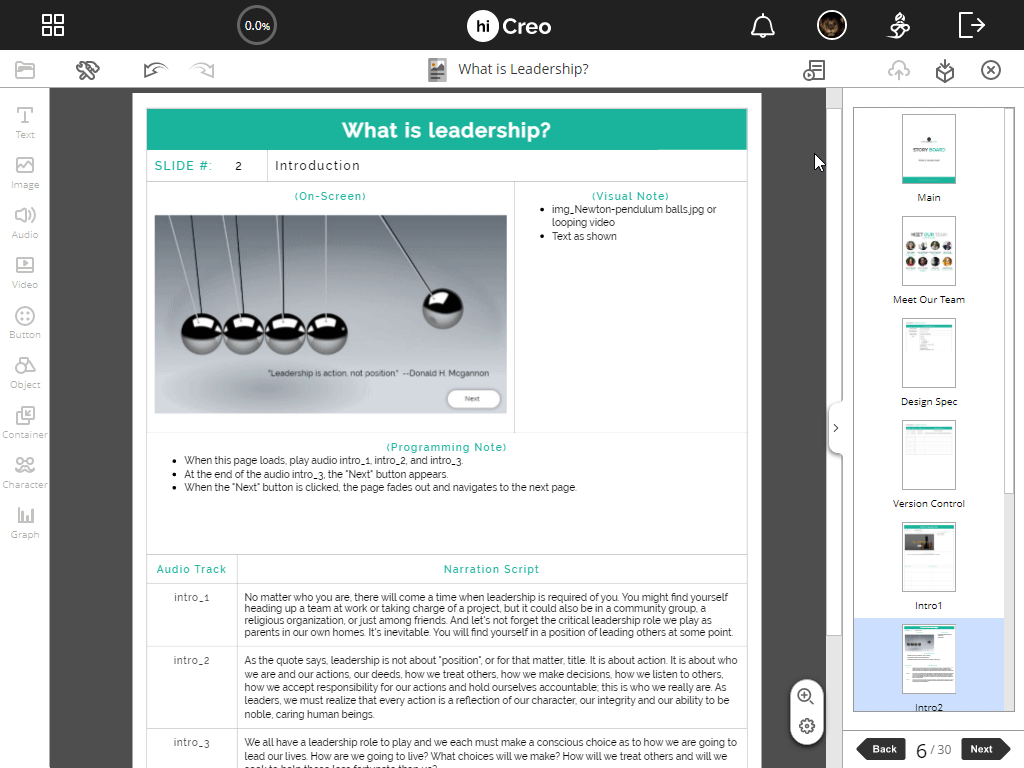Previous Post

Top 5 Free eLearning Authoring Tools for 2023
Attention eLearning enthusiasts! Are you tired of creating online courses using traditional methods? Do you want to spice up your content creation game and take it to the next level? If yes, then you are in for a treat! In this article, we will introduce you to the top 5 free eLearning authoring tools to consider in 2023. But hold on, and there's a twist – Some of these tools are AI-powered! Yes, you heard that right. These eLearning authoring tools come with AI-powered features such as AI assistant, AI text generation, AI image generation, AI image background remover, and AI text-to-speech. These tools make the content creation process faster and more efficient and enable you to customize your online courses with ease.
Next Post

Amazing Free eLearning Storyboard Templates for Download
Picture this: You're designing an eLearning course, pouring countless hours into content creation, navigation structures, and multimedia elements. But wait! Have you ever felt like something is missing? Something that ensures seamless flow visualizes the learner's journey and captures the essence of your instructional design masterpiece. That's where eLearning storyboards come into play, serving as the missing link that bridges the gap between your vision and its successful execution.
Awesome eLearning Storyboard Templates for Free


Latest Blogs
Amazing Free eLearning Storyboard Templates for Download
Awesome eLearning Storyboard Templates for Free
Top 5 Free eLearning Authoring Tools for 2023
The top 5 Storyline 360 alternative eLearning authoring tools
Understanding eLearning: A Comprehensive Guide to Online Learning
Topics
eLearning storyboard templates are the backbone of any successful eLearning program. Storyboards are the visual representation of instructional content and the essential tool for content creators responsible for developing effective online courses. Storyboards are also incredibly helpful for those who work in instructional design, training, and development. Indeed, spending time creating educational content without one is both inefficient and haphazard.
What is an eLearning storyboard template?
Why are eLearning storyboard templates important?
Benefits of using eLearning storyboard templates
Download free eLearning storyboard templates in PDF
Create instructional design storyboard content with Artificial Intelligence
FAQS
What is an eLearning storyboard template?
In simple terms, an eLearning storyboard is a blueprint for your course. It is a visual representation of how your course will look after it has been developed for online delivery.
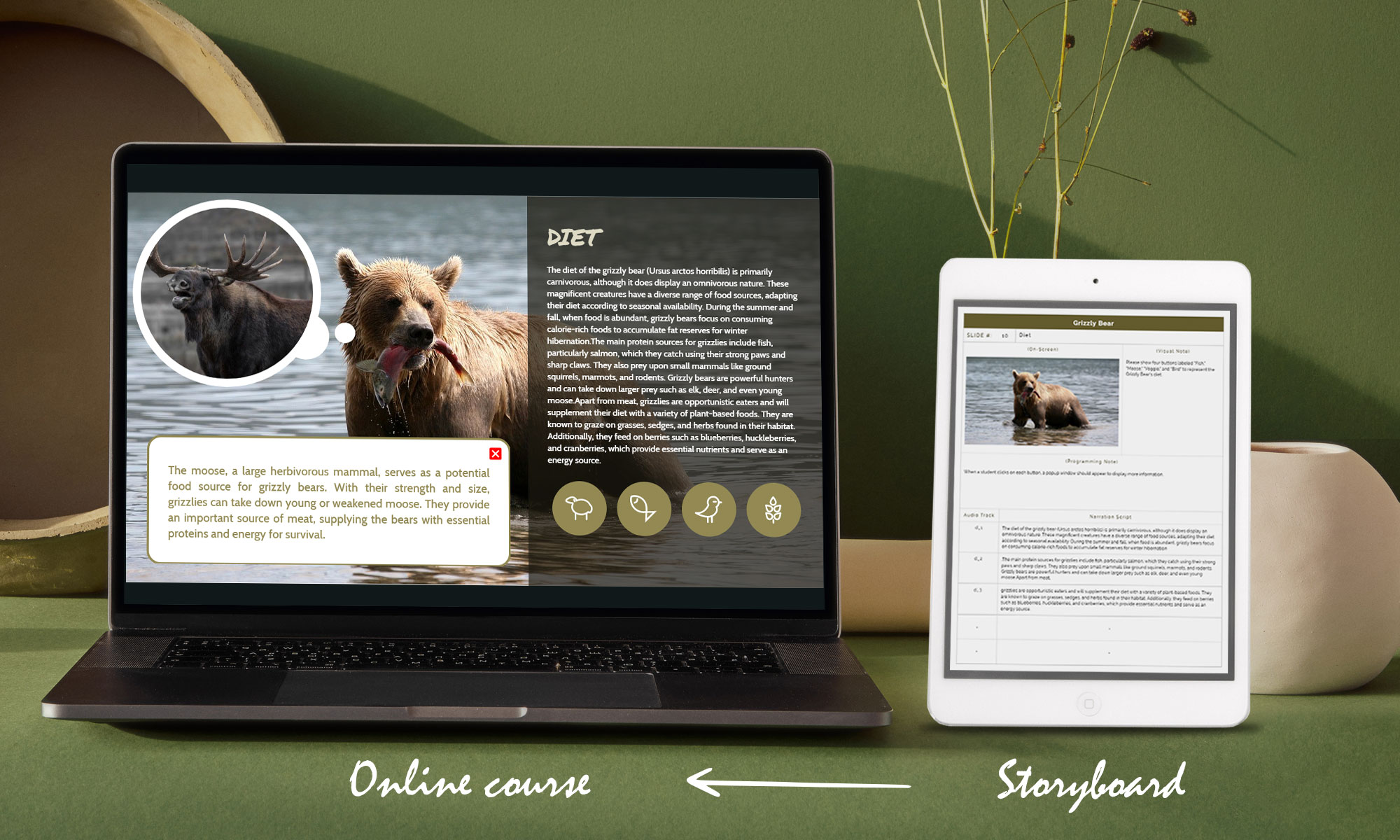
Why are eLearning storyboard templates important?
Effective content development saves much time, energy, and money to develop successful online courses. By defining and organizing their course content in a storyboard, content creators, trainers, and instructors can see courses navigated and mapped out properly, which dissects a course into manageable sections to ensure that the objectives are met in the best way possible.
In his blog post titled "6 Reasons Why Storyboards In eLearning Are So Powerful", Chris Hodgson elucidates on the significance of storyboards in eLearning.
In his blog post titled "6 Reasons Why Storyboards In eLearning Are So Powerful", Chris Hodgson elucidates on the significance of storyboards in eLearning.
Benefits of using eLearning storyboard templates:
There are numerous advantages to using an eLearning storyboard template, from helping teams keep their courses organized and ensuring that course objectives are met effectively to saving development time that can be reinvested to improve the course quality and allowing for better adjustments throughout the course's lifetime.
By using eLearning storyboard templates, content creators, trainers, and developers can focus on building new and innovative ideas, ultimately leading to better eLearning outcomes. Remember, the storyboard template is your best friend when creating effective eLearning content. Using an eLearning storyboard template helps you organize your ideas and also helps you develop an eLearning course that meets your learners' needs. So, why not give it a try and experience yourself the benefits of eLearning storyboard templates?
By using eLearning storyboard templates, content creators, trainers, and developers can focus on building new and innovative ideas, ultimately leading to better eLearning outcomes. Remember, the storyboard template is your best friend when creating effective eLearning content. Using an eLearning storyboard template helps you organize your ideas and also helps you develop an eLearning course that meets your learners' needs. So, why not give it a try and experience yourself the benefits of eLearning storyboard templates?
Download free eLearning storyboard templates in PDF
Free eLearning Storyboard Template #1
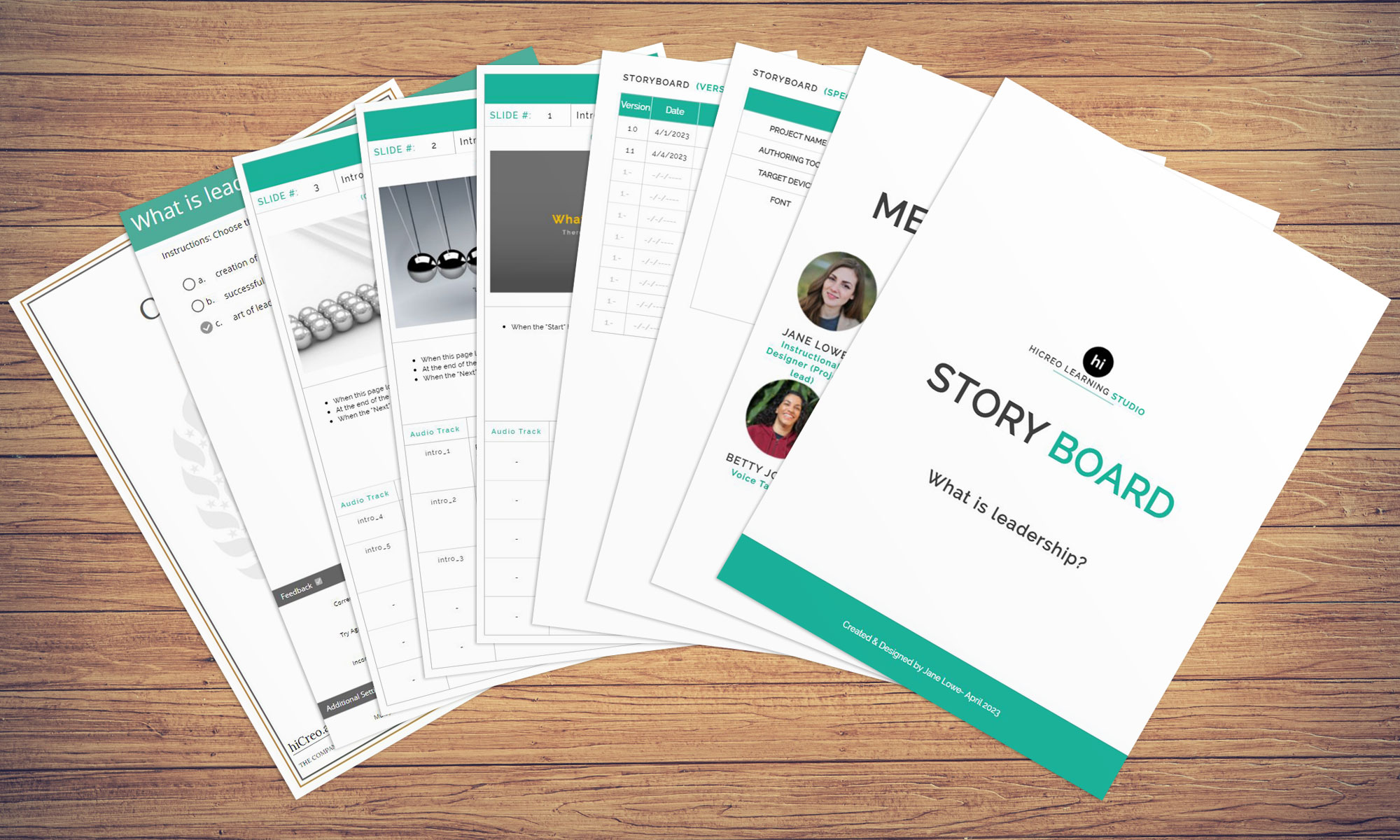
Course Outline
+
- Main
- Meet Our Team
- Design Specification
- Version Control
- Introduction
- ELO A: Essential Competencies for All Level of Leadership
- Essential competencies for all levels of leadership
- Check On Learning
- Summary
- ELO B: Leadership Styles
- Leadership Styles
- Check On Learning
- Summary
- ELO C: Types of Leadership Roles
- Types of Leadership Roles
- Check On Learning
- Summary
- Certificate Of Completion
Free eLearning Storyboard Template #2
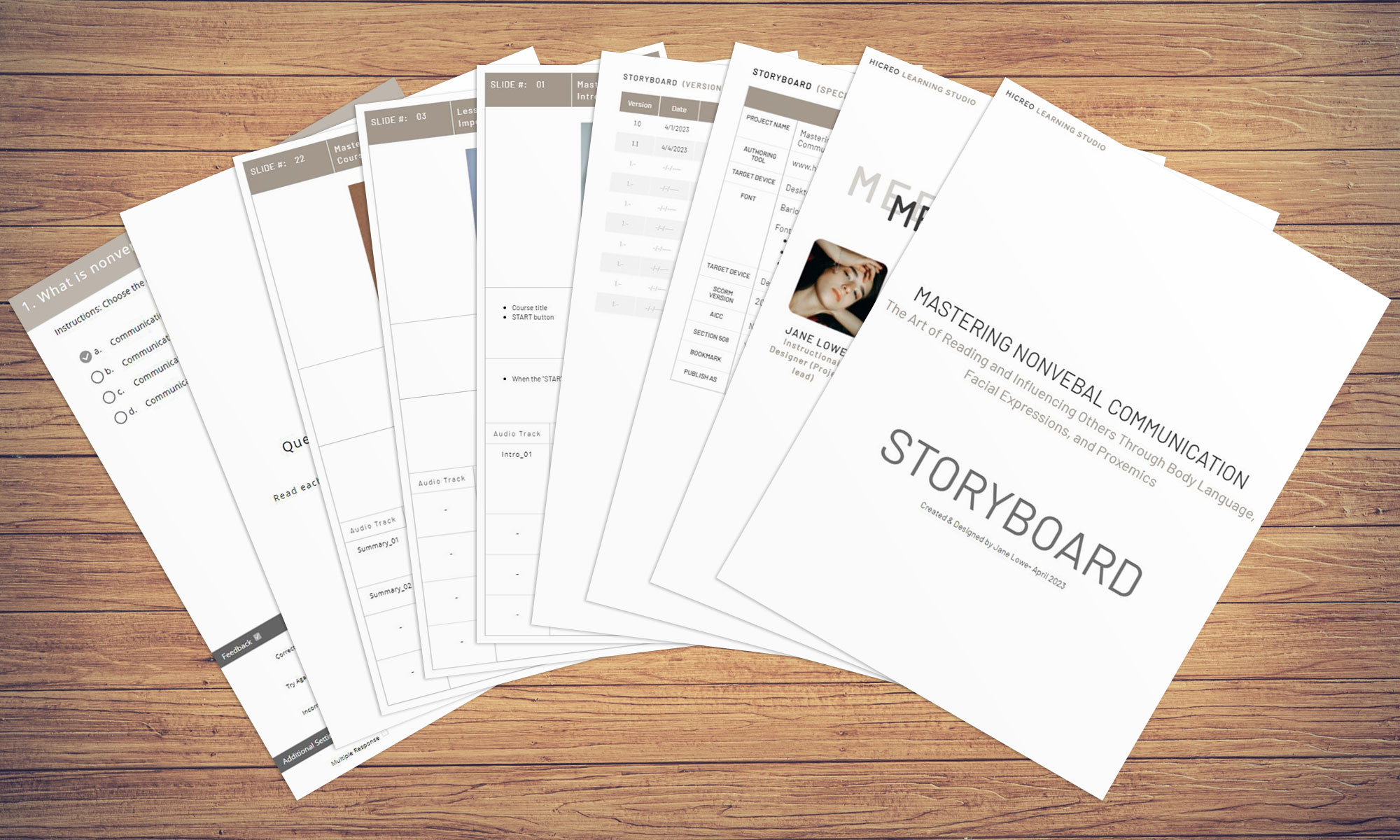
Course Outline
+
- Main
- Meet Our Team
- Design Specification
- Version Control
- Introduction
- Lesson 1: Introduction to Nonverbal Communication
- Defining nonverbal communication
- Importance of nonverbal communication in everyday interactions
- Lesson 2: Understanding Body Language
- Different types of body language (e.g., kinesics, proxemics, haptics)
- How to read and interpret body language
- How body language can be used to influence others
- Lesson 3: Facial Expressions and Microexpressions
- Understanding the different types of facial expressions
- The significance of microexpressions in interpreting emotions
- Techniques for reading and interpreting facial expressions
- Lesson 4: Proxemics and Paralanguage
- Understanding the role of space and distance in nonverbal communication
- How to use proxemics to influence others
- The importance of paralanguage (e.g., tone, pitch, and rhythm) in nonverbal communication
- Lesson 5: Nonverbal Cues in Business and Professional Settings
- How to use nonverbal communication in the workplace
- Nonverbal communication in job interviews and presentations
- Navigating cultural differences in nonverbal communication
- Lesson 6: Advanced Techniques and Applications
- How to use nonverbal communication in persuasion and negotiation
- Detecting deception through nonverbal cues
- Nonverbal communication in virtual and online interactions
- Lesson 7: Conclusion and Next Steps
- Recap of key concepts
- Recommended resources for further learning and development
- Final thoughts on the importance of mastering nonverbal communication.
- Course Summary
- Quiz
Free eLearning Storyboard Template #3
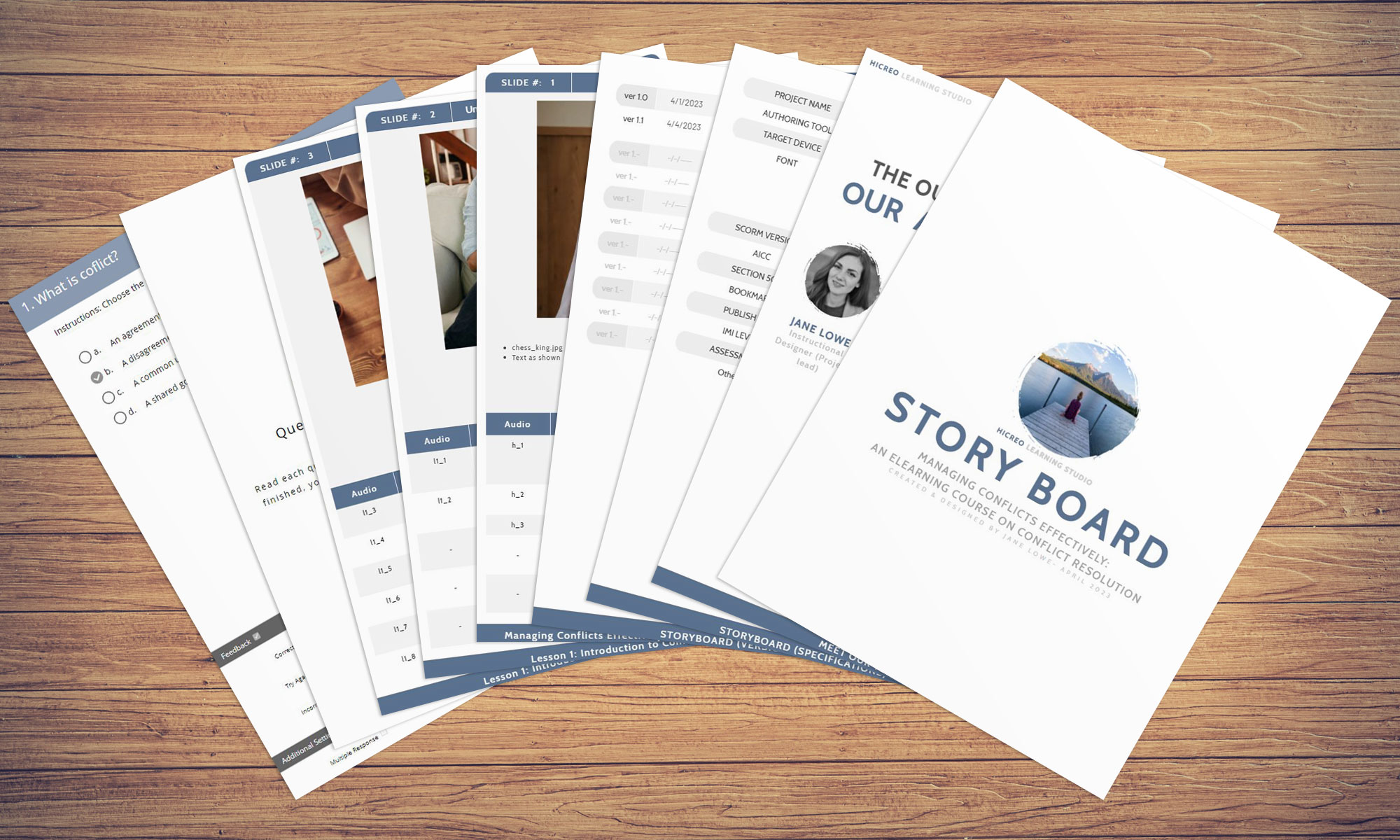
Course Outline
+
- Main
- Meet Our Team
- Design Specification
- Version Control
- Course Introduction
- Lesson 1: Introduction to Conflict Resolution
- Understanding conflict and its impact on relationships and organizations
- The benefits of effective conflict resolution
- Lesson 2: Understanding Different Conflict Resolution Techniques
- Mediation
- Negotiation
- Collaboration
- Compromise
- Arbitration
- Litigation
- Lesson 3: Identifying the Root Cause of Conflicts
- Understanding emotions and perceptions in conflict
- The role of power and interests in conflict
- Communication breakdowns in conflict
- Lesson 4: Communication Skills for Conflict Resolution
- Active listening and empathy
- Effective verbal and non-verbal communication
- Effective verbal and non-verbal communication
- Lesson 5: Dealing with Difficult People and Situations
- Handling passive-aggressive behavior
- Dealing with emotionally charged conflicts
- Navigating conflicts involving authority and hierarchy
- Lesson 6: Conflict Resolution in the Workplace
- Managing workplace conflicts effectively
- Understanding workplace conflict resolution policies and procedures
- Building a positive work environment through conflict resolution
- Lesson 7: Application of Conflict Resolution Skills in Real-Life Situations
- Role-playing and scenario-based exercises
- Practice and feedback on conflict resolution skills
- Final project: creating a conflict resolution plan for a real-life situation
- Course Summary
- Quiz
- Certificate of Completion
Free eLearning Storyboard Template #4
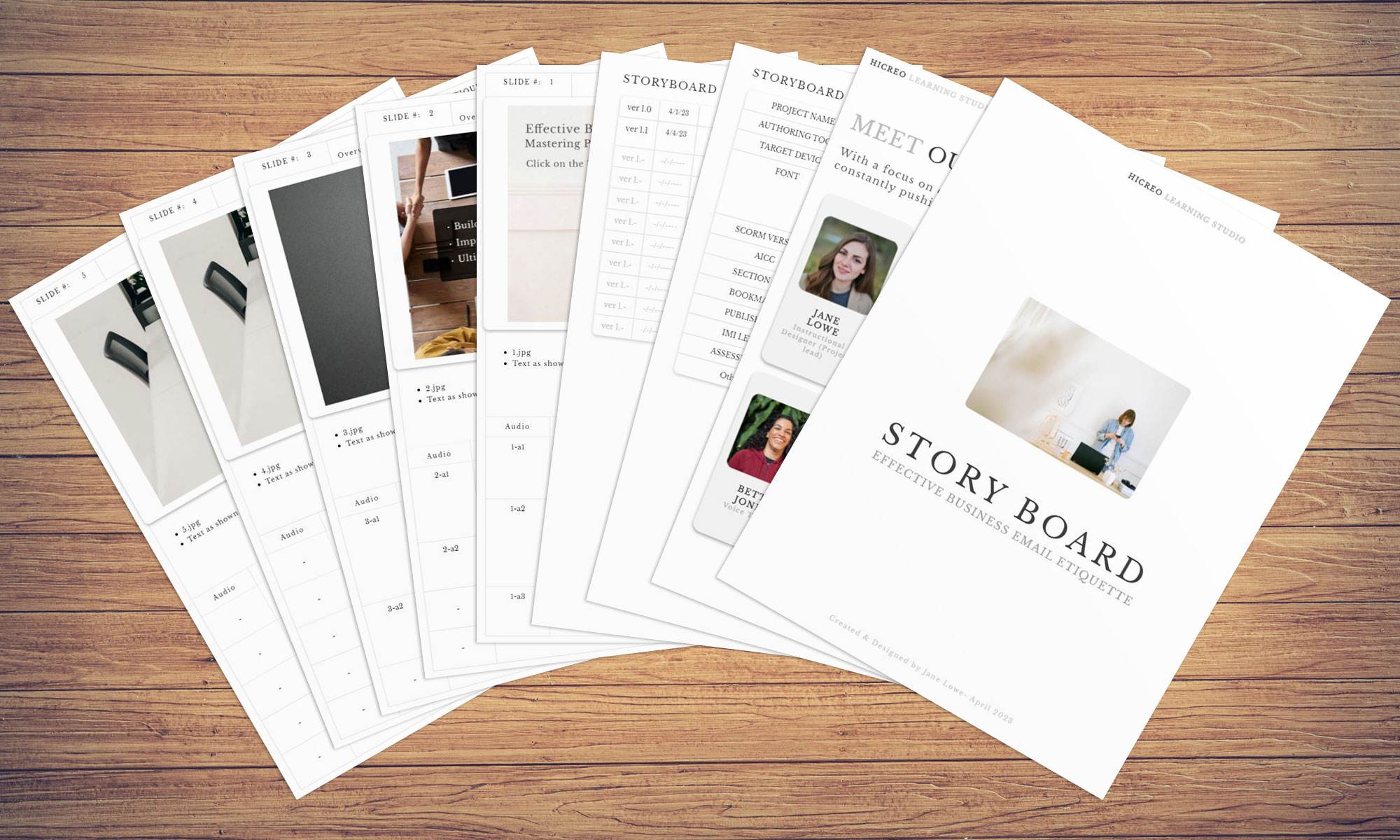
Course Outline
+
- Main
- Meet Our Team
- Design Specification
- Version Control
- Introduction
- Lesson 1: Introduction to Business Email Etiquette
- Overview of the importance of professional communication in the workplace
- Setting the tone and purpose of emails
- Lesson 2: Writing Effective Emails
- Best practices for crafting clear, concise, and effective emails
- Using proper grammar and punctuation
- Formatting and layout considerations
- Lesson 3: Responding to Emails
- Techniques for responding to different types of emails (e.g., complaints, requests, etc.)
- Tips for handling difficult or sensitive situations
- Best practices for maintaining a professional tone
- Lesson 4: Managing Email Overload
- Strategies for managing a high volume of emails
- Tips for prioritizing and organizing emails
- Best practices for avoiding burnout
- Lesson 5: Professional Communication in a Virtual Workplace
- Navigating the challenges of remote work
- Maintaining professionalism and building relationships through virtual communication
- Best practices for video conferencing and online meetings
- Lesson 6: Ethics and Legal Considerations
- Understanding the legal and ethical implications of email communication
- Best practices for maintaining the confidentiality and data security
- Tips for avoiding liability and protecting your organization
- Summarize the key takeaways
- Review of best practices for effective business email etiquette
- Quiz
Free eLearning Storyboard Template #5
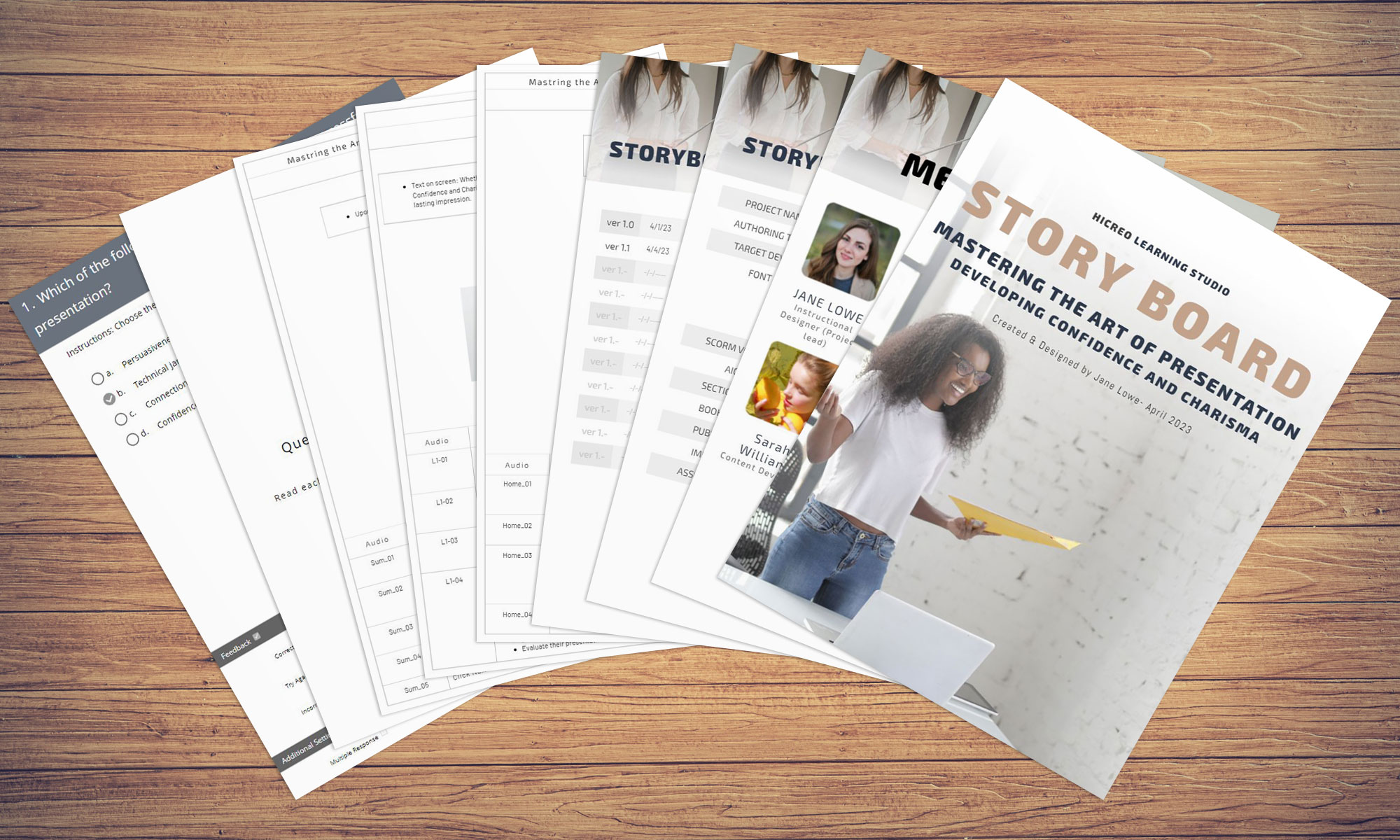
Course Outline
+
- Main
- Meet Our Team
- Design Specification
- Version Control
- Introduction
- Lesson 1: Introduction
- Overview
- Lesson 2: Understanding the Basics of Presentation
- Definition of presentation
- Importance of presentation skills
- Types of presentations
- Lesson 3: Planning and Preparation
- Understanding your audience
- Defining the purpose and goals of the presentation
- Creating a presentation outline
- Gathering and organizing content
- Lesson 4: Delivering the Presentation
- Confidence-building techniques
- Body language and non-verbal communication
- Voice projection and pace D. Use of visual aids
- Lesson 5: Enhancing Presentation Effectiveness
- Storytelling and humor
- Engaging the audience
- Handling nerves and distractions
- Handling questions and objections
- Summary
- Quiz
- Certificate of Completion
Create instructional design storyboard content with Artificial Intelligence - hicreo.com
An AI-powered storyboard utilizes machine learning algorithms to develop educational content and instructional design more quickly and accurately. Essentially, AI helps instructional designers to produce learning materials in a much shorter period while also ensuring that the content is optimized for the learners' needs.
There are numerous advantages to using AI-powered storyboarding in Instructional Design. They include:
There are numerous advantages to using AI-powered storyboarding in Instructional Design. They include:
- Faster production of learning materials
- Consistent and improved course quality
- Increased learner engagement and motivation
- Better understanding of learner behaviors and patterns
- More accurate post-training evaluation and feedback
Step 1
Sign up and log in to www.hicreo.com
Step 2
Click “CREAT”
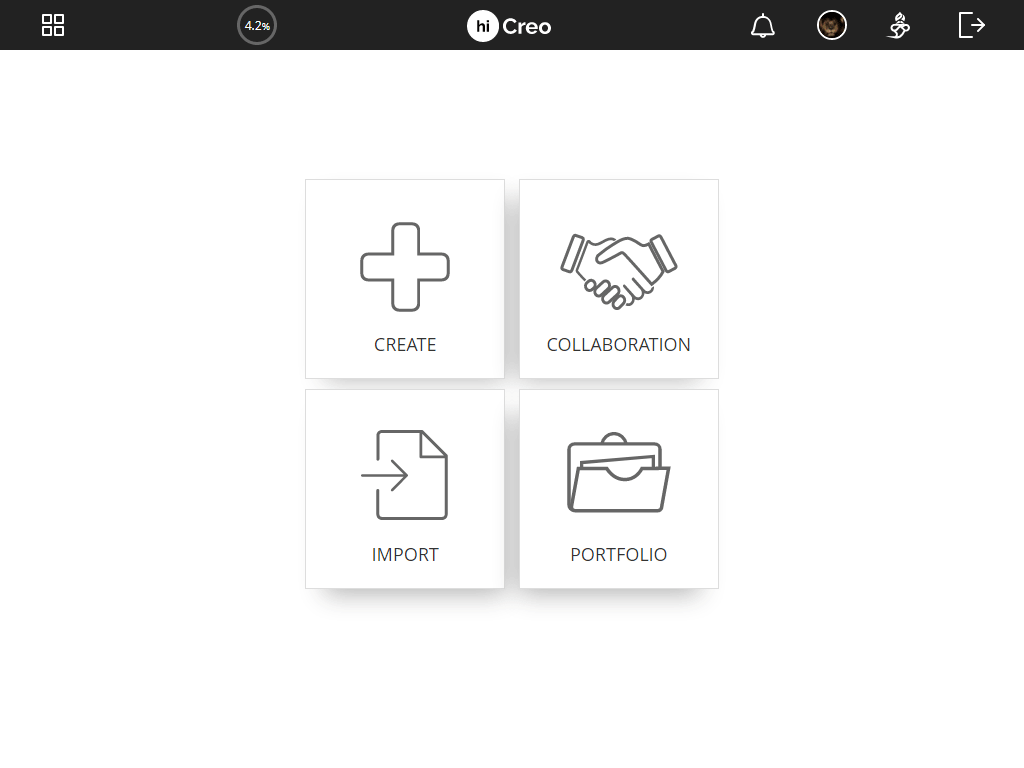

Step 3
Click “STORYBOARD”
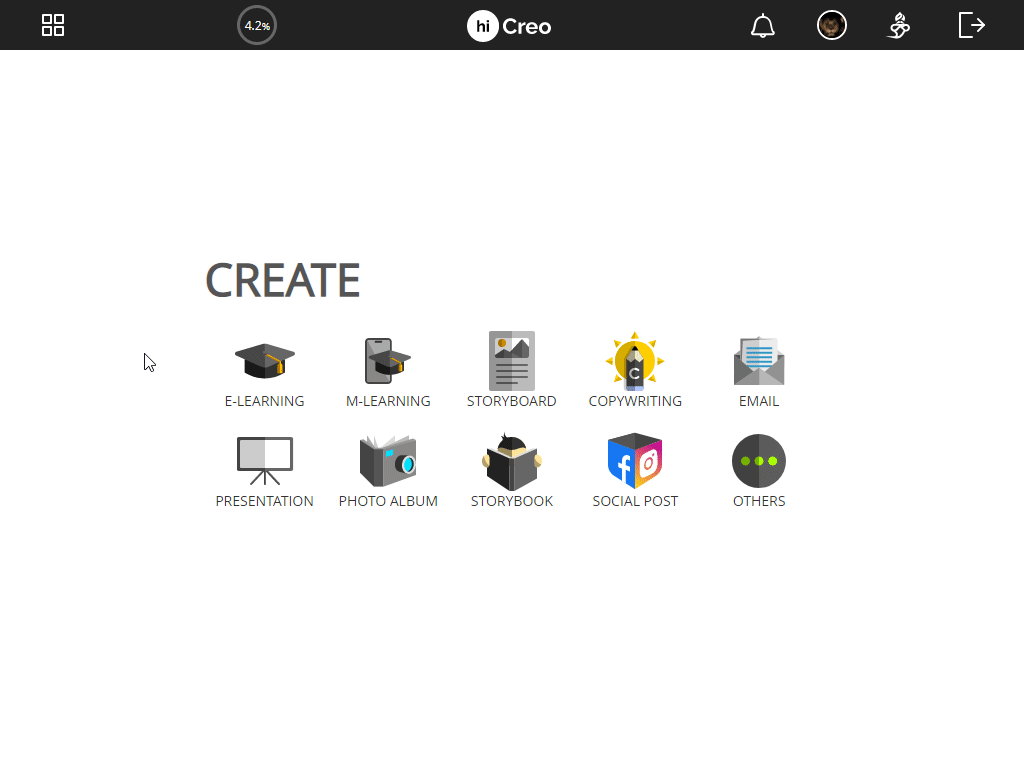

Step 4
Choose a storyboard template from the available options


Step 5
Click “Course Builder”


Step 6
In Course Builder, add, duplicate, delete, and rename as appropriate
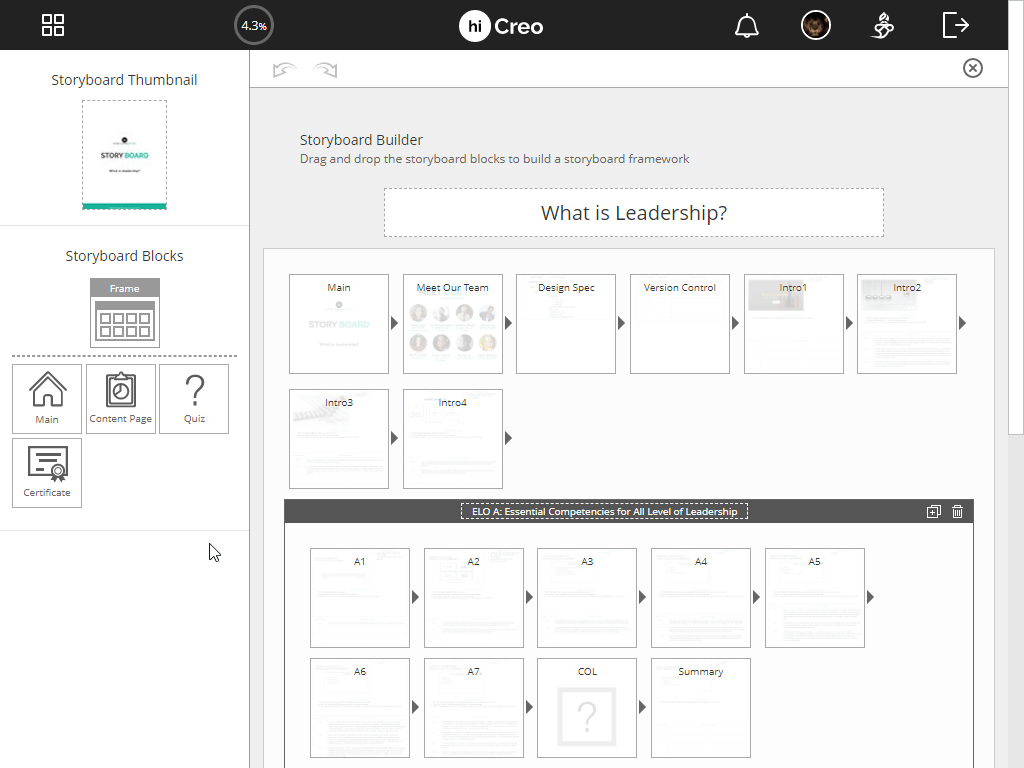

Step 7
Return to the editor screen and start creating
There are 2 ways in which you can generate instructional storyboard content with AI:
There are 2 ways in which you can generate instructional storyboard content with AI:
-
Launch Chat Genie and type in prompts
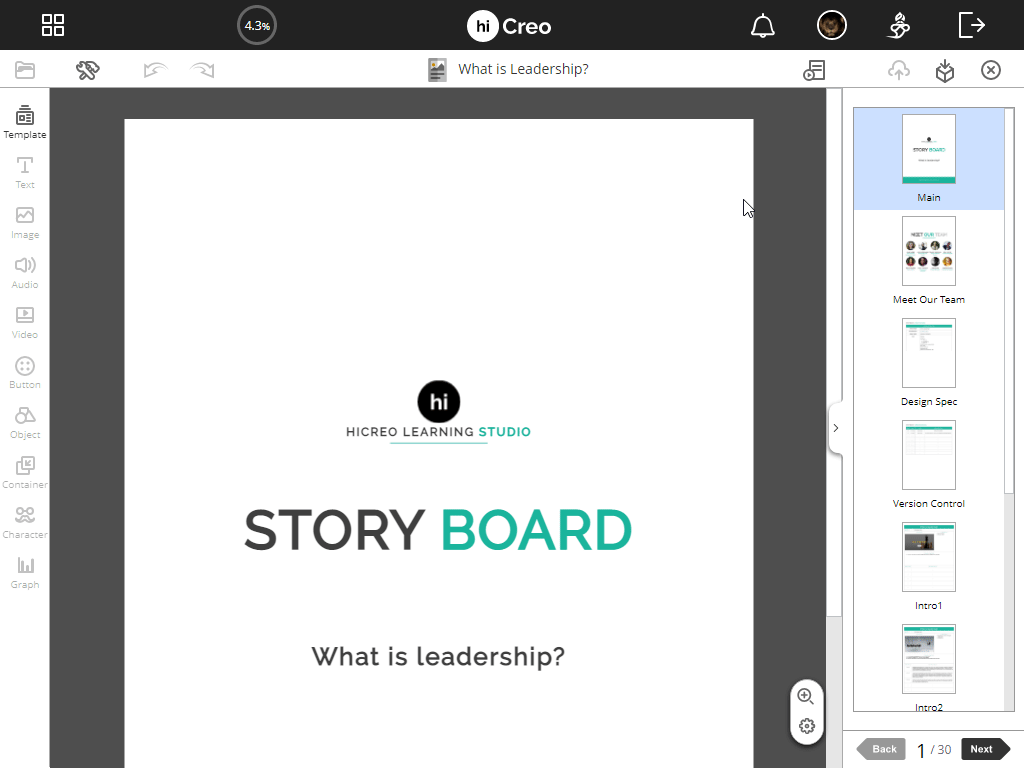
-
Select a text on the screen and click on the AI Genie and type in prompts
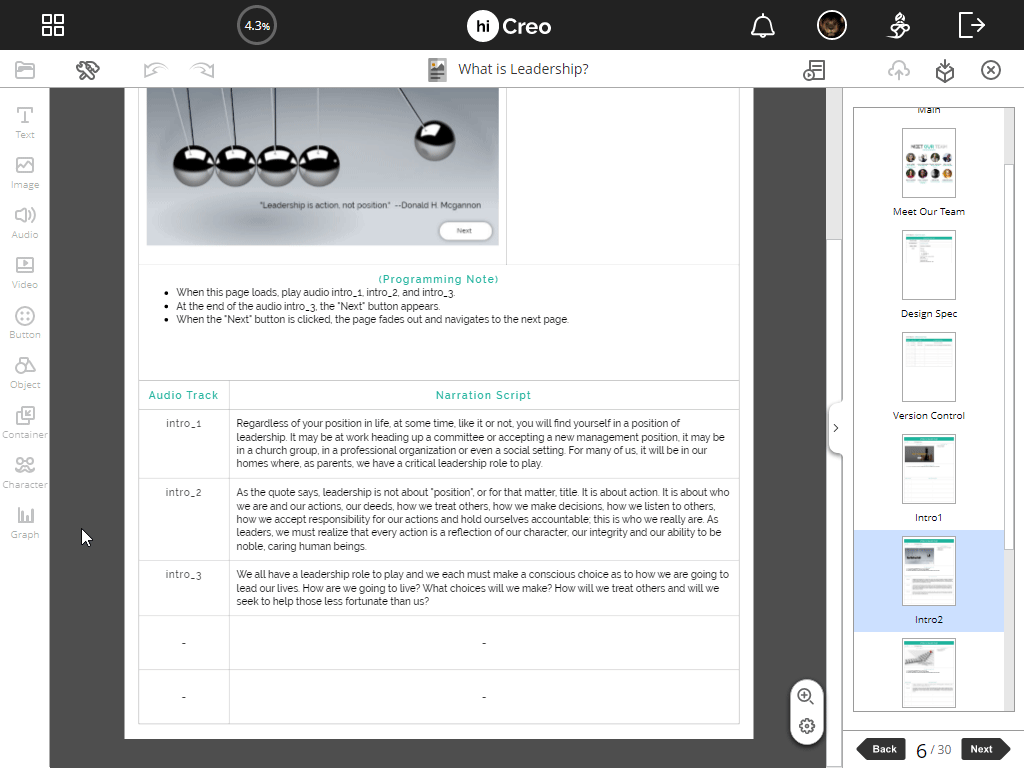
Step 8
Preview and Publish when done
